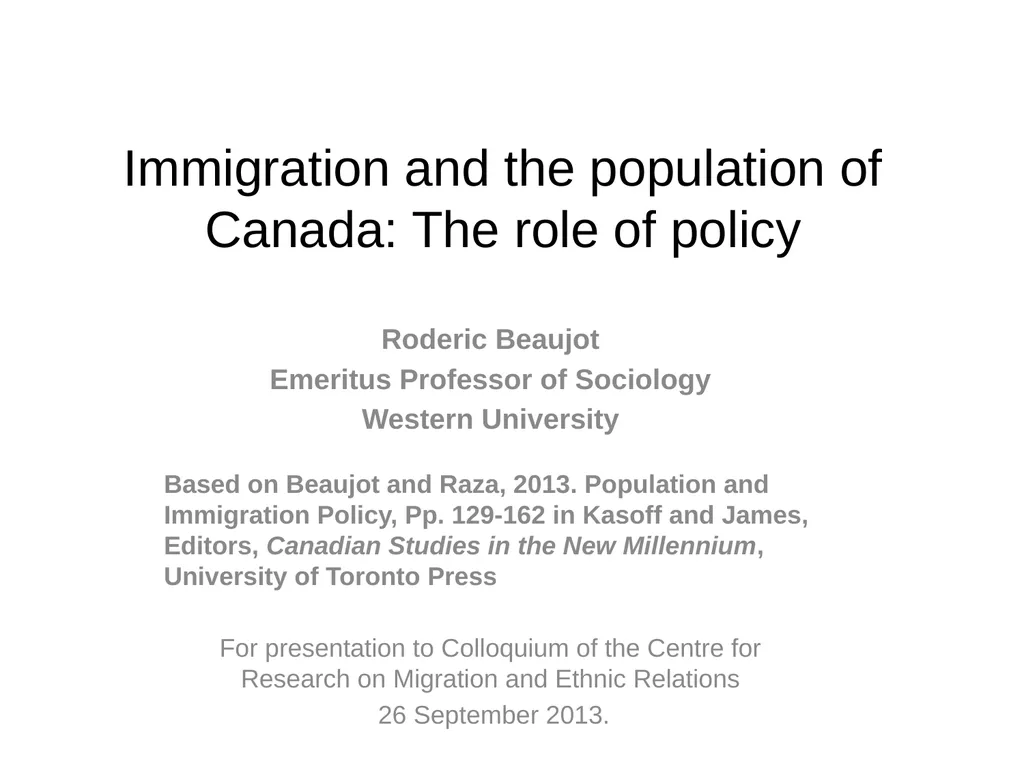Immigration and the population of Canada: The role
Author : liane-varnes | Published Date : 2025-11-08
Description: Immigration and the population of Canada The role of policy Roderic Beaujot Emeritus Professor of Sociology Western University Based on Beaujot and Raza 2013 Population and Immigration Policy Pp 129162 in Kasoff and James Editors
Presentation Embed Code
Download Presentation
Download
Presentation The PPT/PDF document
"Immigration and the population of Canada: The role" is the property of its rightful owner.
Permission is granted to download and print the materials on this website for personal, non-commercial use only,
and to display it on your personal computer provided you do not modify the materials and that you retain all
copyright notices contained in the materials. By downloading content from our website, you accept the terms of
this agreement.
Transcript:Immigration and the population of Canada: The role:
Immigration and the population of Canada: The role of policy Roderic Beaujot Emeritus Professor of Sociology Western University Based on Beaujot and Raza, 2013. Population and Immigration Policy, Pp. 129-162 in Kasoff and James, Editors, Canadian Studies in the New Millennium, University of Toronto Press For presentation to Colloquium of the Centre for Research on Migration and Ethnic Relations 26 September 2013. Purpose Role of immigration and immigration policy in the population history of Canada Implications for Canada and for immigrants Policy discussion: level and composition of immigration Integration of immigrants Outline 1. Context: Migration in population history Conceptualizing migration 2. Phases of immigration in historical and policy context: 1608-1760: New France 1760-1860: British Colony 1860-1896: net out migration 1897-1913: first wave of post-Confederation migration 1914-1945: interlude 1946-1961: post-war white immigration 1962-1988: diversification of origins 1989-present: sustained high levels 3. Implications Demographic: growth, distribution, age structure Socio-cultural and socio-economic World Context: Migration in Population history Zelinski, 1971: mobility transition 1850-1950: North to South 1950-2050: South to North Two periods of globalization 1900-1914 Post-war Context: conceptualizing migration Two questions: whether and where Whether to move: Natural tendency not to move Social integration and life course factors Where to move: streams of origins and destinations -Push-pull factors and barriers -Political Economy: mobile populations and demand for labour in the largest cities (Massey et al., 1994) -Transnational perspectives: networks and institutions (Simmons, 2010) Phases: Pre-contact population Estimate of 300,000 (Charbonneau, 1984) It took almost two centuries, 1608-1790 for the European population to reach this figure. Three centuries of aboriginal depopulation (1600-1900). Phases: New France, 1608-1760 Charbonneau et al., 2000: During the period of New France, it is estimated that at least 25,000 immigrants had spent at least one winter in the new colony, with 14,000 settling permanently, and 10,000 marrying and having descendants in the colony. 1760 Population (white, European): Canada: New France, 70,000 USA: British Colonies, 1,267,800 US/Canada, 1760: 18.1 times Phases: British Colony, 1760-1860 English in Quebec 1765: 500 1791: 10,000 United Empire Loyalists: 40,000 (mostly in 1784) Britain: After war of 1812 and return to peace in Europe and North America: arrivals from Britain increase, … further increases with epidemics in 1830s and potato famine in 1840s. Private and public authorities support immigration from British Isles. Emigration from Canada to New England: gains strength in 1830s for both recent arrivals and population of French descent. Phases: British Colony, 1760-1860 1821-1861:













